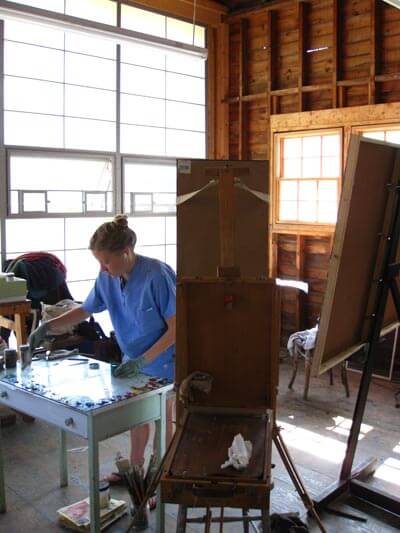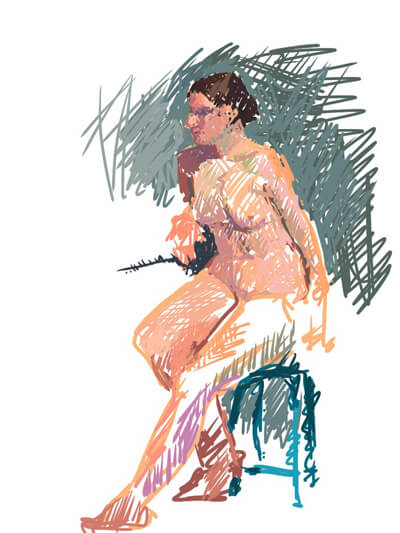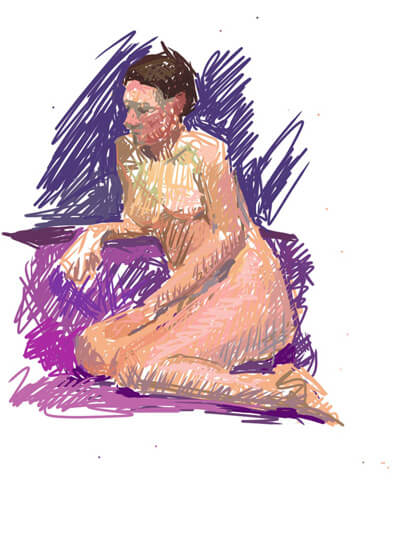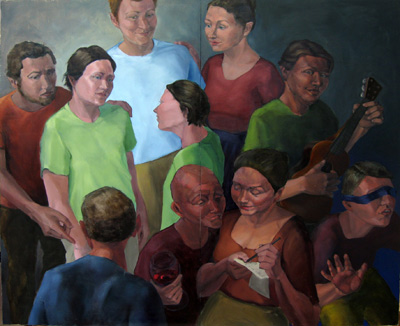Two weeks ago I was in Solomons, MD (my girlfriend had an art opening for a group show of portraits) where I met Katherine Knight, a Washington DC based painter. We started talking about craft and technology and she had to be interviewed on these pages…
During our conversation you mentioned using your iPhone in your creative process/practice. Can you tell me how? Do you consider getting an iPad?
It’s becoming a cliché, but I would say that my iPhone has completely changed my life; particularly the way I conduct research for my studio. Prior to the iPhone, my research tools consisted of my digital camera for taking reference photos, a sketchbook for studies and compositional ideas, my computer for internet research and Photoshop (which I’d use to compose some of the more complicated paintings), a Wacom tablet and drawing stylus, color media (watercolor, gouache, or acrylic paint) for color studies, and various different types of paper for specific tasks. Now I can do all of that on my iPhone. I’ve given up a little in quality- the camera is not as good, and the drawings are a bit clumsy, but it’s certainly sufficient for research, and I’ve gained so much in flexibility. Plus I think the technology is only going to improve. I don’t have to carry as much stuff around with me anymore, and I spend a lot less time at my desk. Before, I would have to consciously put on my Artist Hat. I’d have to think ‘I’m going to the zoo today, better take the camera in case I see something I want to use’. The iPhone is with me all the time, and allows me to easily take my research with me wherever I go, without forethought. I never used to be one of those artists doing sketches all the time out in public. What interests me most is color, and it’s quite a hassle (and sometimes prohibitively messy) to carry color media around with you- even if it’s only colored pencils. The very first thing I did with my iPhone was download a drawing app (ArtStudio), and now I can do color studies absolutely anywhere. I’ve drawn on the Metro between stops, in the car on road-trips, in class while my students are working, even at night in the dark. I can work in full color in museums, directly in front of the paintings- it’s amazing. I’m becoming much more fluent with color, which is helpful when I’m back in front of my easel.

As for the iPad, I caved! My husband and I just bought one to share (which is difficult, but we’re managing). It is a MUCH more advanced machine, and having the bigger screen makes it much easier to work with. But because of its size it’s still not quite as spontaneous as the iPhone. I’m looking forward to having it in class, in museums, and on trips. Ultimately I think it will be nice to have both.


I remember that you mentioned that you were interested in almost rehabilitating the hand in this process. Could you explain this concept?
One of the fears art ‘traditionalists’ have about digital art, is that it obliterates all evidence of the artist’s hand in the final piece. When you look at a piece of digital art, the end result can be so seamless and polished, that you’re not thinking about the person who made it, or the work that went into it. It’s a very different experience than looking at a painting by Rembrandt, where you can see individual brush strokes and appreciate the craftsmanship and virtuosity of the painter.
To be fair, I think a lot of this boils down to the artist’s intent. There are many artists working with traditional media, who go to great pains to hide all evidence of their hand in their work. The point is that as these digital programs become more sensitive, artists have the option of allowing their hand to be more evident, just as they would with any other material. I think David Hockney put it pretty well in this image:

A couple of pieces on your website are animated video stills. What was the idea behind them?
In graduate school I started looking for ways to use digital technology to enhance a traditional painting practice (hence my interest in the iPhone). This video is the only time I’ve used digital media to create a finished product, apart from the sketches I’ve been doing recently. I used Photoshop and my Wacom tablet to animate about 45 seconds worth of a three minute video. Each frame is hand drawn in Photoshop, by tracing a still image from the live-action video, and then discarding the original still. This process is called Rotoscoping, and has been around since the early 1900’s. It took FOREVER, even though I cut the frame rate from 24 frames per second down to six. There are computer programs that would have done it much more quickly, but they did not have the hand-drawn look I was going for.
Conceptually, the video shows a telephone conversation between me and my grandfather, who has dementia. The animation kicks in when his story becomes a little too fanciful to be plausible, even though it’s clear that he believes the story himself. The color palette and composition are very similar to the paintings I was making at the time.
Are you influenced by musical concepts such as rhythm, counterpoint, or maybe pattern repetition?
I certainly address these issues in class with my students. One of my favorite assignments is to have the students describe Botticelli’s Primavera as though it was a symphony: the tree-trunks acting as the beat/percussion, the figures being the melody, and the leaves and flowers as twiddly embellishments, usually identified as strings or flutes. I don’t often think in musical terms specifically when I’m working in my studio, although I’m sure those thoughts are floating around in there somewhere, but music plays a HUGE part in my studio practice. I cannot focus without it; I think it has something to do with helping me move to the right side of my brain, where I am generally more productive. I use music to motivate me, and to control my mood. I’m painting Shakespeare plays currently, and so I also use music to help me get into a certain character or frame of mind. I’ve been listening to a lot of Radiohead to help me with Romeo and Juliet, for example. I’ve been reading and researching the plays, but have been trying to avoid seeing them performed, because I don’t want to be too influenced by someone else’s visual interpretation. But I’ve just downloaded Gustavo Dudamel’s recording of Tchaikovsky & Shakespeare (with the Simón Bolívar Symphony Orchestra), which has themes from Romeo and Juliet, Hamlet, and The Tempest. I can’t wait to listen to this in the studio, and think it’s going to change my approach to The Tempest, in particular.

Are you concerned with a possible loss of craftsmanship because of technology?
Not at all! Every time there is an advance in technology, concerns arise that traditional media might be rendered ‘dead’, or that the technology will allow for cheats and shortcuts that might dilute the purity of the craft. But the fact is that cheats (tricks and devices that allow the artist to circumvent some arduous part of the process- tracing, for example, instead of free-hand drawing) have been around almost as long as the media themselves, and anyway they don’t really work unless the artist already knows what they are doing. They are not a good short-cut for knowledge. It’s commonly known that Vermeer used a camera obscura to help him with drawing and simplification, and no one thinks any the less of him. Even Da Vinci traced his own drawings when transferring them onto canvas. Everyone thought photography would be the death of painting. Instead, photography ultimately gave painters the option of working non-representationally, became a useful and versatile tool for those who wanted to work realistically, and became a valuable art form in its own right. I think that someone who cares about their craft will bring that care into their process no matter what, and that technology is better viewed as an opportunity than a threat.
Katherine Knight is a painter who splits her time between Washington DC, where she teaches at the Corcoran College of Art and Design, and Frankfort KY, where she and her husband have built a studio in a quiet field. Website: http://www.k2art.net























